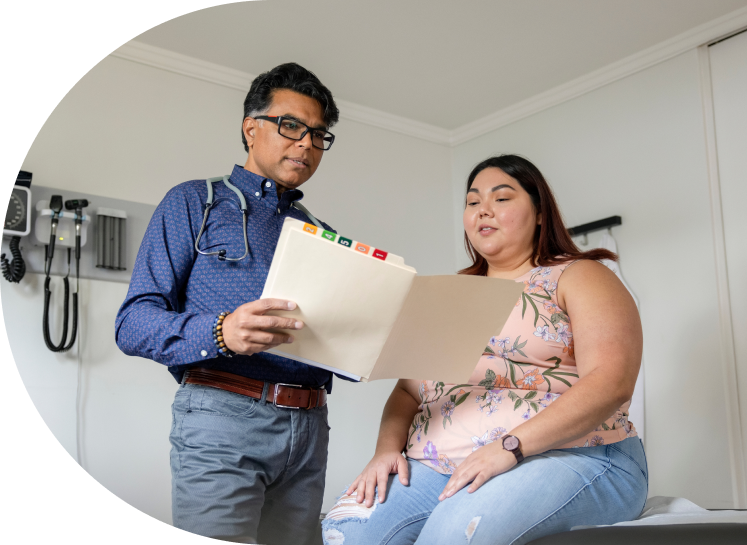What is HS?
hidradenitis suppurativa
Understanding HS is just the start.
Hidradenitis suppurativa (HS) is a chronic, debilitating skin condition that produces boil-like abscesses in approximately 1 in 100 individuals in the United States.1,2
Symptoms of HS
Presenting as painful nodules or boil-like abscesses, HS can present anywhere a hair follicle is present and may grow to be the size of an orange or larger. These affected areas may rupture, causing deep-seated lesions that release an odorous pus-filled or bloody drainage from the body. HS most commonly presents under the armpits, in the groin, buttocks, breasts, and thighs.3
Treatment options
While HS is currently incurable, individualized HS treatment plans may include oral medications, injectable biologics, surgery, pain management, and specialized wound care.4 Even with treatment, significant scarring often occurs.4 Because available treatments have variable and limited efficacy,5 people with HS often turn to alternative medicine to help manage symptoms.6
Mental health impacts
Support is needed throughout care to manage not only the physical pain, but also the stigmatization and social isolation due to symptoms.7 Mental health comorbidities include depression, anxiety, substance use disorders, psychiatric disorders, and increased risk of suicide.7
Improved policies needed
Current gaps in HS research and care mean that people living with HS are suffering financially, physically, and emotionally with delayed or missed diagnoses and lacking healthcare options.8 We are working to highlight the need for policy changes that will increase access to treatment and accelerate research.

Patient portrayal.
Did you know?
3.3m
Estimated number of people living in the U.S. who currently have HS, approximately 1 in 100 in this country.1
21y
The mean age of HS onset.9
25%
Percentage of those with the disease who were properly diagnosed before the age of 25.8
3x
In the U.S., Black people are 3x more likely to have HS than White people.1
74%
Percentage of people currently diagnosed with HS in the U.S. who are women.1
References
- Nguyen TV, Damiani G, Orenstein LAV, Hamzavi I, Jemec GB. Hidradenitis suppurativa: an update on epidemiology, phenotypes, diagnosis, pathogenesis, comorbidities and quality of life. J Eur Acad Dermatol Venereol. 2021;35(1):50‐61.
- Snyder CL, Chen SX, Porter ML. Obstacles to early diagnosis and treatment of hidradenitis suppurativa: current perspectives on improving clinical management. Clin Cosmet Investig Dermatol. 2023;16:1833-1841.
- Ballard K, Shuman VL. Hidradenitis suppurativa. In: StatPearls [Internet]. Treasure Island, FL: StatPearls Publishing. January 2023. Last updated April 17, 2023. Accessed January 2, 2024. https://www.ncbi.nlm.nih.gov/books/NBK534867/
- Hidradenitis Suppurativa (Acne Inversa): Symptoms & treatments. Cleveland Clinic. (n.d.). https://my.clevelandclinic.org/health/diseases/17716-hidradenitis-suppurativa
- Alikhan A, Sayed C, Alavi A, et al. North American clinical management guidelines for hidradenitis suppurativa: a publication from the United States and Canadian Hidradenitis Suppurativa Foundations: Part I: diagnosis, evaluation, and the use of complementary and procedural management. J Am Acad Dermatol. 2019;81(1):76-90.
- Price KN, Thompson AM, Rizvi O, et al. Complementary and alternative medicine use in patients with hidradenitis suppurativa. JAMA Dermatol. 2020;156(3):345‐348.
- Phan K, Huo YR, Smith SD. Hidradenitis suppurativa and psychiatric comorbidities, suicides and substance abuse: systematic review and meta-analysis. Ann Transl Med. 2020;8(13):821.
- Analysis of data extracted from Real Chemistry's IPM.ai multi-payer real-world claims dataset (IPM.ai. Integrate Claims (https://www.ipm.ai/). Includes patients with a code for HS (ICD10: L73.2, ICD9: 705.83) included on ≥2 claims, and at least one claim from December 2021‐December 2022.
- Naik HB, Paul M, Cohen SR, Alavi A, Suàrez-Fariñas M, Lowes MA. Distribution of self-reported hidradenitis suppurativa age at onset. JAMA Dermatol. 2019;155(8):971-973.







